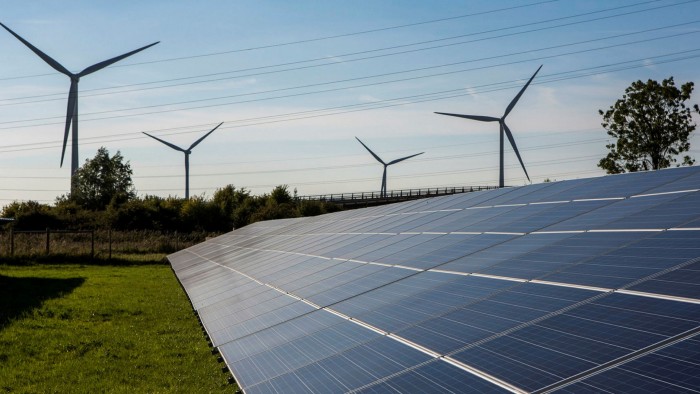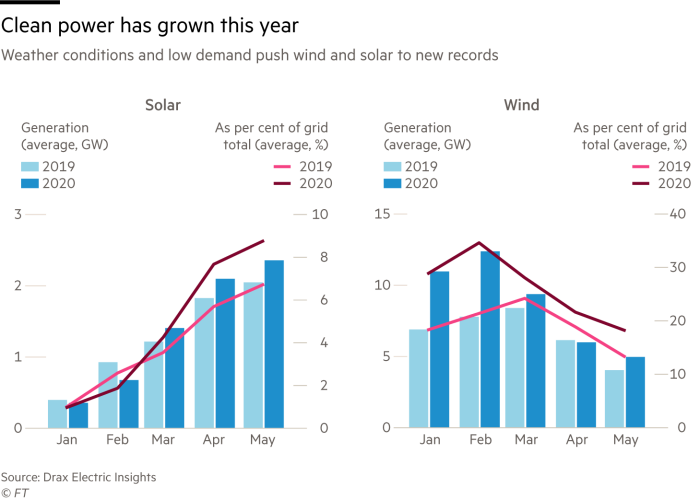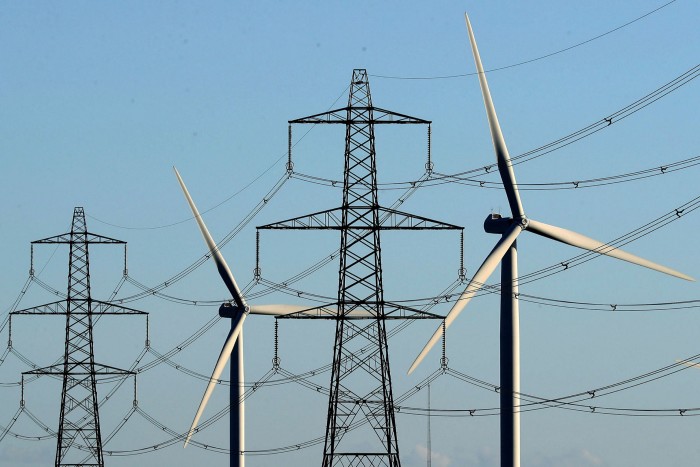UK renewables prove a shining success during pandemic

Simply sign up to the Renewable energy myFT Digest -- delivered directly to your inbox.
At a time when huge swaths of the UK economy are suffering from the coronavirus downturn, one sector is having a relatively good crisis: renewable energy.
During the past month, records for clean energy have been broken repeatedly, as the combination of ample sun and wind, and low electricity demand has led to an unprecedented level of use of renewable power in the UK.
“We’ve been enjoying it,” said Steve Riley, chief executive of clean energy company Cubico, which owns 3.3GW of renewable assets, including 300MW in the UK. “We’ve had tremendous weather these last few weeks . . . the energy created and sold has been more than expected.”
A new record for sun power was set in April — with solar farms powering nearly 30 per cent of the grid at their peak, due to bright weather and low pollution.
The UK is also in the midst of setting a new record for the longest period the grid has ever operated without coal — 34 days as of May 14 and counting.
A big drop in electricity demand since lockdown started in March has pushed some traditional power plants off the grid entirely, but wind and solar have kept servicing the need as they have preferential access to the grid.

They accounted for nearly 30 per cent of power generation over the past two months, compared with 23 per cent of generation for the same period last year, according to data from Drax Electric Insights.
These conditions have created an unexpected glimpse of what the UK grid will look like in future as more clean energy comes online, according to National Grid.
“We have been planning for operational conditions like those we see at the moment . . . however, the lockdown has temporarily accelerated these conditions by several years,” said Roisin Quinn, head of control at National Grid Electricity System Operator.
In a sign of the unusual circumstances, National Grid Electricity System Operator recently took a nuclear reactor partially offline to maintain grid stability, paying EDF Energy to reduce output at its Sizewell B nuclear reactor.
“It is definitely an eye-popping moment for the energy business,” said Björn Ullbro, vice-president at Wartsila Energy Business, a Finnish infrastructure company with UK operations. “This is a level of renewable power, as a share of the total, that we were expecting maybe in 10 years’ time — and all of the sudden it is accelerating.”

Demand for electricity in the UK has dropped 14 per cent in the past month, while prices are 40 per cent lower, on average, than the same period in 2019.
Although low power prices typically hurt power producers, most UK wind and solar farms are protected from the volatility of the market price by subsidies or offtake agreements that guarantee a certain price.
“Power prices have come down significantly, and we are seeing those effects across market,” said Michael Bonte-Friedheim, chief executive of NextEnergy, one of the largest owners of solar power in Europe. The company has 720MW of solar operating in the UK and a further 2,000MW under development there.
However, Mr Bonte-Friedheim added that revenues had increased from across NextEnergy’s European assets this spring due to the sunny weather, as most of their solar providers sell their power through subsidised contracts.
The company is still pressing ahead with construction plans, announcing last week that it had secured funding for two large, unsubsidised plants in the UK.
The Covid-19 lockdown has, nonetheless, brought logistical challenges for new wind and solar projects in the UK — with delays in construction and in approvals, with supply chain challenges and higher financing costs.
The Solar Trade Association, which had been expecting 1GW of new solar construction this year, said some of that was likely to be pushed back.
“The bit of the industry that is installing new systems has faced delays. A lot of the industry has had to pause,” said Chris Hewett, chief executive.
“It’s been an unprecedented challenge across the economy and energy sector, and I think renewable energy has held up pretty well,” said Nina Skorupska, head of the Renewable Energy Association. She pointed out that biomass power plants, which rely on wood pellets often shipped from overseas, have suffered from recent supply chain disruptions, while wind and solar plans have continued to produce power because they do not require a fuel supply.
“The tricky elements will be around the roles of the regulators, and local authorities, in being able to give timely assurance on planning, and various regulatory permissions,” she added.
In onshore wind for example, an effective ban on new construction was lifted in April after years of lobbying, however the pandemic will mean that any new onshore wind projects will take longer to construct.
But many in the sector are still optimistic. Mr Riley of Cubico said that clean energy was one of the better-performing sectors within power production. “If you look at the impact on the oil companies and the energy sector, I think renewables are seen as something of a safe haven.”
Comments